| Listing 1 - 10 of 24 | << page >> |
Sort by
|
Book
ISBN: 0262275376 0585481156 Year: 2003 Publisher: Cambridge, Mass. : MIT Press,
Abstract | Keywords | Export | Availability | Bookmark
 Loading...
Loading...Choose an application
- Reference Manager
- EndNote
- RefWorks (Direct export to RefWorks)
Ecological restoration is the process of repairing human damage to ecosystems. It involves reintroducing missing plants and animals, rebuilding soils, eliminating hazardous substances, ripping up roads, and returning natural processes such as fire and flooding to places that thrive on their regular occurrence. Thousands of restoration projects take place in North America every year. In Nature by Design, Eric Higgs argues that profound philosophical and cultural shifts accompany these projects. He explores the ethical and philosophical bases of restoration and the question of what constitutes good ecological restoration.Higgs explains how and why the restoration movement came about, where it fits into the array of approaches to human relationships with the land, and how it might be used to secure a sustainable future. Some environmental philosophers and activists worry that restoration will dilute preservation and conservation efforts and lead to an even deeper technological attitude toward nature. They ask whether even well-conceived restoration projects are in fact just expressions of human will. Higgs prefaces his responses to such concerns by distinguishing among several types of ecological restoration. He also describes a growing gulf between professionals and amateurs. Higgs finds much merit in criticism about technological restoration projects, which can cause more damage than they undo. These projects often ignore the fact that changing one thing in a complex system can change the whole system. For restoration projects to be successful, Higgs argues, people at the community level must be engaged. These focal restorations bring communities together, helping volunteers develop a dedication to place and encouraging democracy.
Restoration ecology. --- ENVIRONMENT/General --- PHILOSOPHY/General
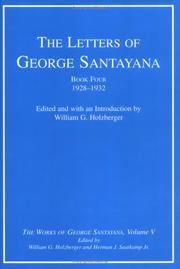
ISBN: 1282098233 9786612098239 026228295X 142941913X 9780262282956 9780262194792 0262194791 9780262194570 0262194570 Year: 2003 Publisher: Cambridge, Mass. : MIT Press,
Abstract | Keywords | Export | Availability | Bookmark
 Loading...
Loading...Choose an application
- Reference Manager
- EndNote
- RefWorks (Direct export to RefWorks)
The fourth of eight books of the correspondence of George Santayana.George Santayana published The Realm of Matter (1930) and The Genteel Tradition at Bay (1931). He continued work on Book Three of Realms of Being, The Realm of Truth, and on his novel, The Last Puritan. Citing his commitment to his writing and his intention to retire from academia, he declined offers from Harvard University for the Norton Chair of Poetry and for a position as William James Professor of Philosophy, as well as offers for positions at the New School for Social Research and Brown University. The deaths of his half sisters, Susan Sturgis de Sastre and Josephine Sturgis, in 1928 and 1930, respectively, were extremely distressing to him. Santayana and Charles Strong continued their epistolary debate over the nature and perception of reality and the problem of knowledge. The book also includes letters to Robert Bridges, Cyril Clemens, Morris R. Cohen, Curt John Ducasse, Sydney Hook, Horace Meyer Kallen, Walter Lippmann, Ralph Barton Perry, William Lyon Phelps, and Herbert W. Schneider. Santayana sent many letters with articles and reviews to journalists Wendell T. Bush, Henry Seidel Canby, Wilbur Cross, and John Middleton Murry. Discussion of his novel and continuing work on Realms of Being took place with Otto Kyllmann and John Hall Wheelock, his editors at Constable and Scribner's. Although Santayana now made the Hotel Bristol in Rome his permanent residence, he continued to travel in England, France, and Italy.
LITERARY COLLECTIONS --- Letters --- Philosophers --- Santayana, George, --- PHILOSOPHY/General --- Scholars
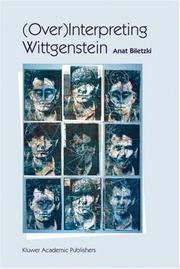
ISBN: 1402013272 940070822X 1402013264 Year: 2003 Volume: 319 Publisher: Dordrecht ; Boston ; London Kluwer Academic Plubishers
Abstract | Keywords | Export | Availability | Bookmark
 Loading...
Loading...Choose an application
- Reference Manager
- EndNote
- RefWorks (Direct export to RefWorks)
(Over)Interpreting Wittgenstein will be read by philosophers investigating Wittgenstein and by scholars, interpreters, students, and specialists, in both analytic and continental philosophy. It will intrigue readers interested in issues of interpretation and cultural studies. This book tells the story - as yet untold - of Wittgenstein interpretation during the past eighty years. It provides different interpretations, chronologies, developments, and controversies. It aims to discover the (socio-cultural rather than psychological) motives and motivations behind the philosophical community's project of interpreting Wittgenstein. As a cultural history of ideas, it traces the parallelism between Wittgenstein interpretation and the move from metaphysics, to language, to postmodernism effected in the twentieth century.
Philosophy. --- Language and languages—Philosophy. --- History. --- Modern philosophy. --- Philosophy, general. --- Philosophy of Language. --- History, general. --- Modern Philosophy. --- Modern philosophy --- Annals --- Auxiliary sciences of history --- Mental philosophy --- Humanities
Book
ISBN: 0262270021 0585480974 9780262270021 9780585480978 Year: 2003 Publisher: Cambridge, Mass. : MIT Press,
Abstract | Keywords | Export | Availability | Bookmark
 Loading...
Loading...Choose an application
- Reference Manager
- EndNote
- RefWorks (Direct export to RefWorks)
In Natural Ethical Facts William Casebeer argues that we can articulate a fully naturalized ethical theory using concepts from evolutionary biology and cognitive science, and that we can study moral cognition just as we study other forms of cognition. His goal is to show that we have "softly fixed" human natures, that these natures are evolved, and that our lives go well or badly depending on how we satisfy the functional demands of these natures. Natural Ethical Facts is a comprehensive examination of what a plausible moral science would look like. Casebeer begins by discussing the nature of ethics and the possible relationship between science and ethics. He then addresses David Hume's naturalistic fallacy and G. E. Moore's open-question argument, drawing on the work of John Dewey and W. V. O. Quine. He then proposes a functional account of ethics, offering corresponding biological and moral descriptions. Discussing in detail the neural correlates of moral cognition, he argues that neural networks can be used to model ethical function. He then discusses the impact his views of moral epistemology and ontology will have on traditional ethical theory and moral education, concluding that there is room for other moral theories as long as they take into consideration the functional aspect of ethics; the pragmatic neo-Aristotelian virtue theory he proposes thus serves as a moral "big tent." Finally, he addresses objections to ethical naturalism that may arise, and calls for a reconciliation of the sciences and the humanities. "Living well," Casebeer writes, "depends upon reweaving our ethical theories into the warp and woof of our scientific heritage, attending to the myriad consequences such a project will have for the way we live our lives and the manner in which we structure our collective moral institutions."
Ethics, Evolutionary --- Ethics --- Philosophy --- Philosophy & Religion --- Ethics, Naturalistic --- Evolutionary ethics --- Naturalistic ethics --- Ethical relativism --- Ethics, Evolutionary. --- PHILOSOPHY/General --- COGNITIVE SCIENCES/General
Book
ISBN: 0262276720 0585481725 Year: 2003 Publisher: Cambridge, Mass. : MIT Press,
Abstract | Keywords | Export | Availability | Bookmark
 Loading...
Loading...Choose an application
- Reference Manager
- EndNote
- RefWorks (Direct export to RefWorks)
Kojin Karatani's Transcritique introduces a startlingly new dimension to Immanuel Kant's transcendental critique by using Kant to read Karl Marx and Marx to read Kant. In a direct challenge to standard academic approaches to both thinkers, Karatani's transcritical readings discover the ethical roots of socialism in Kant's Critique of Pure Reason and a Kantian critique of money in Marx's Capital.Karatani reads Kant as a philosopher who sought to wrest metaphysics from the discredited realm of theoretical dogma in order to restore it to its proper place in the sphere of ethics and praxis. With this as his own critical model, he then presents a reading of Marx that attempts to liberate Marxism from longstanding Marxist and socialist presuppositions in order to locate a solid theoretical basis for a positive activism capable of gradually superseding the trinity of Capital-Nation-State.
Kant, Immanuel, --- Kant, Immanuel, --- Kant, Immanuel, --- Marx, Karl, --- Marx, Karl, --- Marx, Karl, --- Contributions in political science. --- Contributions in economics. --- Contributions in political science. --- Contributions in economics. --- PHILOSOPHY/General

ISBN: 0262072394 0262571617 0262274523 0585450625 0262293145 9780262274524 9780585450629 9780262072397 9780262571616 Year: 2003 Publisher: Cambridge, Mass. : MIT Press,
Abstract | Keywords | Export | Availability | Bookmark
 Loading...
Loading...Choose an application
- Reference Manager
- EndNote
- RefWorks (Direct export to RefWorks)
According to the widespread conceptualist view, all mental contents are governed by concepts an individual possesses. In recent years, however, an increasing number of philosophers have argued for the indispensability of nonconceptual content based on perceptual, emotional, and qualitative experiences; informational and computational states; memory; and practical knowledge. Writers from disciplines as varied as the philosophy of mind, cognitive science, artificial intelligence, epistemology, linguistics, religious psychology, and aesthetics have challenged conceptualism.This book offers some of the most important work on nonconceptual content in the philosophy of mind and psychology. It is divided into four parts. Part 1 presents influential positions that have helped to shape the contemporary debate. Part 2 focuses on arguments informed specifically by the naturalization of intentionality or the characterization of computational structure. Part 3 offers various attempts at motivating the need for nonconceptual content based on experiential phenomena such as perception, emotion, and memory. Finally, part 4 considers whether nonconceptual content can be used to explain the behavior of entities lacking conceptual capacities in addition to the actions of individuals possessing concepts.
Cognitive psychology --- philosophy --- Theory of knowledge --- kennisleer --- filosofie --- epistemology --- wijsgerige psychologie --- cognitieve psychologie --- Concepts. --- Content (Psychology) --- #PBIB:2003.2 --- Begrippen --- Concepten --- Concepts --- Contenu (Psychologie) --- Inhoud (Psychologie) --- Mental content --- Concept formation --- Psychology --- Abstraction --- Knowledge, Theory of --- Perception --- PHILOSOPHY/General
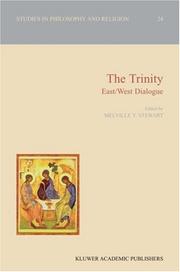

ISBN: 1402017286 9048164753 9401703930 Year: 2003 Volume: 24 Publisher: Dordrecht ; Boston ; London Kluwer Academic Publishers
Abstract | Keywords | Export | Availability | Bookmark
 Loading...
Loading...Choose an application
- Reference Manager
- EndNote
- RefWorks (Direct export to RefWorks)
East/West Summit on the Holy Trinity Held in Moscow - A stellar cast from the Society of Christian Philosophers/West and the Russian Orthodox Church/East met to discuss the mystery of God as three in one. Theologians and philosophers, typically rivals, synergized in their pursuit of truth and understanding regarding this central, unifying Christian belief, demonstrating respective strengths in marvellous complementary array. His holiness Alexei II, Patriarch of Moscow and all Russia extended greetings and Metropolitan Filaret of Minsk set the stage. History still has its shining moments. The next best thing to being there are the papers that were presented and polished for this volume.
Trinity --- Theology, Doctrinal --- Triads (Philosophy) --- Appropriation (Christian theology) --- God (Christianity) --- Godhead (Mormon theology) --- Holy Spirit --- Trinities --- Tritheism --- Philosophy. --- Religion—Philosophy. --- Religion. --- Philosophy, general. --- Philosophy of Religion. --- Religious Studies, general. --- Religion, Primitive --- Atheism --- Irreligion --- Religions --- Theology --- Mental philosophy --- Humanities
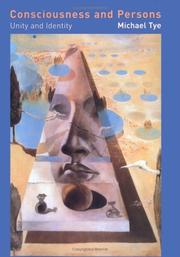
ISBN: 0262285304 1423728580 9780262285308 9781423728580 026220147X 9780262201476 Year: 2003 Publisher: Cambridge, Mass. MIT Press
Abstract | Keywords | Export | Availability | Bookmark
 Loading...
Loading...Choose an application
- Reference Manager
- EndNote
- RefWorks (Direct export to RefWorks)
In Consciousness and Persons: Unity and Identity, Michael Tye takes on the thorny issue of the unity of consciousness and answers these important questions: What exactly is the unity of consciousness? Can a single person have a divided consciousness? What is a single person? Tye argues that unity is a fundamental part of human consciousness--something so basic to everyday experience that it is easy to overlook. For example, when we hear the sound of waves crashing on a beach and at the same time see a red warning flag, there is an overall unity to our experience; the sound and the red shape are presented together in our consciousness. Similarly, when we undergo a succession of thoughts as we think something through, there is an experience of succession that unifies the thoughts into a conscious whole. But, Tye shows, consciousness is not always unified. Split-brain subjects, whose corpus callosum has been severed, are usually taken to have a divided or disunified consciousness. Their behavior in certain situations implies that they have lost the unity normal human subjects take for granted; it is sometimes even supposed that a split-brain subject is really two persons. Tye begins his account by proposing an account of the unity of experience at a single time; this account is extended over the succeeding chapters to cover bodily sensations at a single time and perceptual experience, bodily sensations, conscious thoughts, and felt moods at a single time. Tye follows these chapters with a discussion of the unity of experience through time. Turning to the split-brain phenomenon, he proposes an account of the mental life of split-brain subjects and argues that certain facts about these subjects offer support for his theory of unity. Finally, addressing the topic of the nature of persons and personal identity, Tye finds the two great historical accounts--the ego theory and the bundle theory--lacking and he makes an alternative proposal. He includes an appendix on the general representational approach to consciousness and its many varieties, because of the relevance of representationalism to the theory of unity being adanced.
Consciousness --- Whole and parts (Philosophy) --- Philosophy & Religion --- Philosophy --- Ganzheit (Philosophy) --- Mereology --- Totality (Philosophy) --- Unity (Philosophy) --- Wholeness --- Categories (Philosophy) --- Apperception --- Mind and body --- Perception --- Psychology --- Spirit --- Self --- Consciousness. --- PHILOSOPHY/General --- COGNITIVE SCIENCES/General
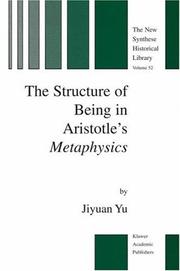
ISBN: 1402015372 9401039917 9401000557 Year: 2003 Volume: 52
Abstract | Keywords | Export | Availability | Bookmark
 Loading...
Loading...Choose an application
- Reference Manager
- EndNote
- RefWorks (Direct export to RefWorks)
In his Metaphysics, Aristotle claims that he is seeking to establish a science of being. Being, at the most general level, is divided by Aristotle into the following four types: 1. Accidental being 2. Being as truth 3. Potential/actual being l 4. Per se being Per se (kath hauto) being can also be translated as "being in its own right" or "intrinsic being". This type of being has been referred to by Aristotle in different ways. The list of per se beings includes substance, quantity, quality, place, time, etc. , and this is also the list ofcategories. At Meta. ix. l, 1045b28 Aristotle calls this list the "categories of being" (hai kategoriai tou ontos). At Meta. vi. 2, 1026a36 and ix. 1O, 1051a33-b2 per se being is called "being with reference to the figures ofpredication" (ta schemata tes kategorias, or "figures ofcategories,,). 2 Of these four types of being, accidental being is briefly treated in Meta. vi. 2-3 and there Aristotle claims that the study of accidental being can be dismissed on the grounds that accidental being is indeterminate and cannot be 3 the object ofknowledge. He also does not pay much attention to being as truth and treats it briefly in two short texts: Meta. viA and ix. 1O.
Being --- Etre (Philosophie) --- Ontologie --- Ontology --- Zijn (Filosofie) --- Zijnsleer --- Ontology. --- Aristotle. --- Philosophy --- Metaphysics --- Necessity (Philosophy) --- Substance (Philosophy) --- Aristoteles. --- Aristotle --- Philosophy. --- Philosophy, Ancient. --- Metaphysics. --- Philosophy, general. --- Classical Philosophy. --- History of Philosophy. --- God --- Philosophy of mind --- Ancient philosophy --- Greek philosophy --- Philosophy, Greek --- Philosophy, Roman --- Roman philosophy --- Mental philosophy --- Humanities

ISBN: 1402012179 9048162645 9401703531 9781402012174 Year: 2003 Publisher: Dordrecht Kluwer Academic
Abstract | Keywords | Export | Availability | Bookmark
 Loading...
Loading...Choose an application
- Reference Manager
- EndNote
- RefWorks (Direct export to RefWorks)
The intertwinement of EC law and national law may create unforeseeability in situations where EC law invades the national cases, which gives rise to the very question of legal certainty in EC law. This study contributes to the contemporary discussion, which wrestles with the following questions in particular: - What have been the visions and objectives for European integration in the last decades? - How to describe European Union as a political entity and a legal system? - What is the relationship between legal certainty, rule of law, various general principles and human rights? - What is the core of legal certainty on the basis of the case study? - What kind of legal arguments and patterns of justification are there from a comparative perspective? - How has the term 'legal certainty' been defined in the Nordic legal theory? - How predictable and acceptable are the interpretations of the European Court of Justice - is it "running wild"? Legal certainty relates to the principle of non-retroactivity and the protection of legitimate expectations in particular, but more profoundly it can be related to the conceptual scale for weighing up and balancing between formal justice and material fairness in legal decision-making. This scale is illustrated by presenting the terms 'formal', 'factual' and 'substantive' legal certainty.
Law --- Legal certainty --- Interpretation and construction --- Legal certainty. --- Interpretation and construction. --- Political science. --- Philosophy. --- Public international law. --- Philosophy of Law. --- Political Science. --- Philosophy, general. --- Public International Law . --- Law of nations --- Nations, Law of --- Public international law --- Mental philosophy --- Humanities --- Administration --- Civil government --- Commonwealth, The --- Government --- Political theory --- Political thought --- Politics --- Science, Political --- Social sciences --- State, The --- Law - European Economic Community countries - Interpretation and construction
| Listing 1 - 10 of 24 | << page >> |
Sort by
|

 Search
Search Feedback
Feedback About
About Help
Help News
News